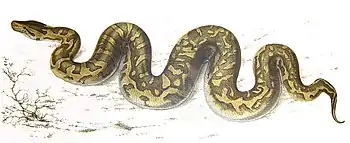Southern African rock python
The Southern African rock python (Python natalensis) is a large python species native to Southern Africa inhabiting savanna and woodland.[1] It was first described by Andrew Smith in 1833.[2] Growing a length of more than 5 m (16 ft), this is one of the largest snakes in the world.
| Southern African rock python | |
|---|---|
 | |
| Scientific classification | |
| Domain: | Eukaryota |
| Kingdom: | Animalia |
| Phylum: | Chordata |
| Class: | Reptilia |
| Order: | Squamata |
| Suborder: | Serpentes |
| Family: | Pythonidae |
| Genus: | Python |
| Species: | P. natalensis |
| Binomial name | |
| Python natalensis Smith, 1833 | |
 | |
Range of Python sebae
Range of Python natalensis
Range of hybrids | |
| Synonyms | |
| |
Description


The Southern African rock python has a colouration that is similar to its northern relative, however it is described as being "drabber". Below the light stripe on both snakes' head, the southern species has a narrower dark patch that resembles a stripe instead of a patch. The Central African rock python (Python sebae) has two prominent light lines from the nose, over the eye to the back of the head, which are much duller in the Southern African rock python. The northern species has considerably larger head scales.[3][4] It is also noticeably inferior in size to size the Central African rock python.[4]
Size


The Southern African rock pythons reach an average length of between 2.8 and 4 m (9 ft 2 in and 13 ft 1 in).[5] Individuals longer than 4.6 m (15 ft) are rare.[6] Regarding body length and mass, this species exhibits sexual dimorphism, as females are significantly larger and heavier than males.[7] Of 75 individuals measured in South Africa the longest female was 4.34 m (14.2 ft) long and weighed 53.4 kg (118 lb). The largest male was 4.23 m (13.9 ft) long and weighed 31.1 kg (69 lb).[8] There is one reliable record of a living specimen reaching 5.56 m (18.2 ft).[6] The longest South African python measured 5.8 m (19 ft), recorded in the former Transvaal.[9]
References
- Alexander, G.J. & Tolley, K.A. (2021). "Python natalensis". IUCN Red List of Threatened Species. 2021: e.T13300560A13300564. Retrieved 19 April 2022.
- Smith, A. (1849). "Python natalensis". Illustrations of the zoology of South Africa : consisting chiefly of figures and descriptions of the objects of natural history collected during an expedition into the interior of South Africa, in the years 1834, 1835, and 1836; fitted out by "the Cape of Good Hope Association for exploring Central Africa" : together with a summary of African zoology, and an inquiry into the geographical ranges of species in that quarter of the globe. London: Smith, Elder and Co. p. 42–44.
- "Difference from P. sebae".
- "Snake Comparison – African Rock Python vs Southern African Python".
- Spawls, K.; Howell, R. & Drewes, J A. (2002). A Field Guide to the Reptiles of East Africa. London: Academic Press. pp. 305–310. ISBN 0-12-656470-1.
- FitzSimons, F. W. (1930). Pythons and their ways. London: George G. Harrap & Co. Ltd. pp. 12–67.
- Broadley, D. G. (1984). "A review of geographical variation in the African Python, Python sebae (Gmelin)". British Journal of Herpetology. 6: 359–367.
- Alexander, G. J. (2007). "Thermal Biology of the Southern African Python (Python natalensis): Does temperature limit its distribution?". In Henderson, R. W.; Powell, R. (eds.). Biology of the Boas and Pythons. Eagle Mountain: Eagle Mountain Publishing Company. pp. 51–75. ISBN 978-0-9720154-3-1.
- Branch, W. R. & Haacke, W. D. (1980). "A Fatal Attack on a Young Boy by an African Rock Python Python sebae". Journal of Herpetology. 14 (3): 305–307.
